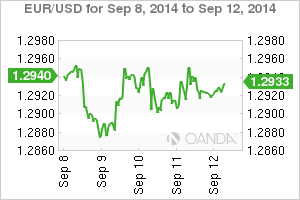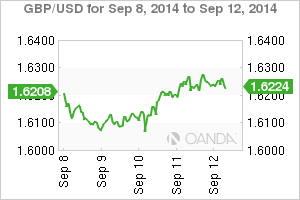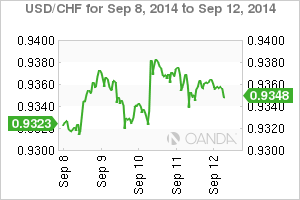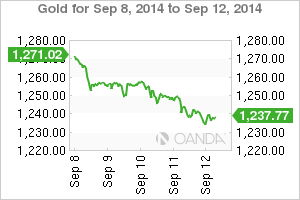Scottish "No" picks up momentum
Sterling try's to fill in plummeting gap
Russian Bear is not endangered
Sterling is closing out the week holding on to its late Thursday's gains (£1.6250) after another poll on Friday morning revealed a stronger "No" count for Scottish independence.
The September 11 Survation online poll for the Daily Record & Sunday Mail happens to be the same pollster that sent the pound plummeting (£1.6053) at the beginning of the week when pro-separatists took the lead. With independence odds being slashed, the short-term dump-sterling panic seems to be over for now. Currently, investors look more comfortable and willing to buy the pound on dips.
Pound Bulls Have Problems Closing the Gap
Nevertheless, the GBP bulls are struggling to close the downside gap (initial overshoot down to lows) at £1.6287 that dominates almost anyone's daily charts. The previous two-day bullish outlook, from the pound's 10-month low (£1.6053), will technically come under renewed pressure if the gap fails to be filled. At the moment, GBP's £1.6307 remains a key upside psychological barrier, while through £1.6146 the downside should be capable of handily opening up again to test the 10-month low in a hurry.
Even European bourses have found some fresh legs (FTSE 100 +0.2%, DAX +0.1%) ahead of the North American handover. Exchanges snapped a five-session losing streak after Thursday's soft U.S. economic data (unemployment claims +315k versus +304k) and the introduction of further European Union-U.S. sanctions against Russia. Perhaps next week's Federal Open Market Committee's (FOMC) outcome may again put global equities under pressure. Investors are anticipating that the Federal Reserve may soon signal a rise in its interest rate policy. If the lack of clarity remains an issue, investors will need to take it upon themselves to set the tone despite the current uptick in geopolitical pressures. Remember, Scottish voters go to the polls next Thursday, and the results will be known on Friday.
Russia's Ruble Remains on the Back Foot
There is still no reprieve for the Russian ruble after the Bank of Russia kept its benchmark rates on hold this Friday morning. The dollar again has managed to hit a new record high -- USD/RUB 37.727 -- supported by a fresh round of E.U.-imposed sanctions introduced last Monday that the U.S. reportedly matched yesterday. Details of the U.S. sanctions will be revealed later today. Obviously not helping the RUB's cause is the broad-based emerging market currency selloff in anticipation of U.S. interest rate divergence. The Fed is expected to highlight the potential change in its monetary policy next week.
What to Expect Next Week
Investors should expect the current uptick in intraday volatility to remain intact supported by geopolitical events, a few central bank meetings, and the Scottish referendum.
The Reserve Bank of Australia will kick-start the week with its Monetary Policy Meeting minutes being released on Monday. A less dovish Fed has been persecuting the carry trades despite a supporting Aussie jobs number. Investors will also attempt to decipher interest rate clues from a speech Bank of Japan Governor Haruhiko Kuroda will make. Currently, they are looking for any sign that Prime Minister Shinzo Abe is pushing for further monetary stimulus.
Scottish referendum fever continues to grip market price action, and though the odds for the country to vote to leave the U.K. has lessened, sterling's fate rests on next Thursday's Scottish independence vote. Along with the vote, expect U.K. retail sales to also occupy the Bank of England's Governor Mark Carney.
A fear of the Fed taking a more hawkish stance at its two-day meeting that ends next Wednesday is keeping both European and U.S. bond yields elevated. U.S. policymakers are expected to shed some light on plans to raise interest rates. The market will be focusing intently on the FOMC press conference after the federal-funds rate decision.
On Thursday, the Swiss National Bank (SNB) will set its Libor (London Interbank Offered Rate) though no changes are expected. However, Swiss authorities could be put to the test if the EUR's downfall escalates and encroaches on the two-year-old EUR/CHF floor at €1.2000. There is no reason to assume the appetite for SNB intervention is diminished at this point. In fact, the pressure for action has intensified.
This article is for general information purposes only. It is not investment advice or a solution to buy or sell securities.
Opinions are the authors — not necessarily OANDA’s, its officers or directors. OANDA’s Terms of Use and Privacy Policy apply. Leveraged trading is high risk and not suitable for all. You could lose all of your deposited funds.
Recommended Content
Editors’ Picks
AUD/USD could extend the recovery to 0.6500 and above

The enhanced risk appetite and the weakening of the Greenback enabled AUD/USD to build on the promising start to the week and trade closer to the key barrier at 0.6500 the figure ahead of key inflation figures in Australia.
EUR/USD now refocuses on the 200-day SMA

EUR/USD extended its positive momentum and rose above the 1.0700 yardstick, driven by the intense PMI-led retracement in the US Dollar as well as a prevailing risk-friendly environment in the FX universe.
Gold struggles around $2,325 despite broad US Dollar’s weakness

Gold reversed its direction and rose to the $2,320 area, erasing a large portion of its daily losses in the process. The benchmark 10-year US Treasury bond yield stays in the red below 4.6% following the weak US PMI data and supports XAU/USD.
Bitcoin price makes run for previous cycle highs as Morgan Stanley pushes BTC ETF exposure

Bitcoin (BTC) price strength continues to grow, three days after the fourth halving. Optimism continues to abound in the market as Bitcoiners envision a reclamation of previous cycle highs.
US versus the Eurozone: Inflation divergence causes monetary desynchronization

Historically there is a very close correlation between changes in US Treasury yields and German Bund yields. This is relevant at the current juncture, considering that the recent hawkish twist in the tone of the Federal Reserve might continue to push US long-term interest rates higher and put upward pressure on bond yields in the Eurozone.



